- Sustainability
- DE&I
- Pandemic
- Finance
- Legal
- Technology
- Regulatory
- Global
- Pricing
- Strategy
- R&D/Clinical Trials
- Opinion
- Executive Roundtable
- Sales & Marketing
- Executive Profiles
- Leadership
- Market Access
- Patient Engagement
- Supply Chain
- Industry Trends
Pharm Exec's 15th Annual Industry Audit
As market headwinds persist, our latest industry review of shareholder value reveals a sharp performance differential between companies that pursue a strategy of specialized therapeutic focus and those that continue to rely on line diversity, size and scale.
A Tale of Two Paths
Since 2002, Pharm Exec’s Industry Audit has tracked the fortunes of a cross-section of publicly traded big Pharma players on the basis of a distinctive marker of performance: how well does management do in providing value to shareholders? This year’s results cover the 2014-2015 period and continue the trend toward a mixed bag of results, with the key distinction being between companies with the innovation-based pricing power to set their own course and those that remain dependent on the fortunes of a volatile, increasingly access-constrained market.
Overall, 2014-2015 has our 23 profiled companies taking a back seat in comparison to the group’s spectacular command performance in the 2012-2013 Audit. But any damage is mitigated by the enviable position the biopharmaceutical sector still holds in comparison to other sectors: revenues and profits in biopharma continue to outpace the growth of the overall US economy. The industry is also well positioned internationally, although coming months are likely to see more exposure to currency fluctuations as the global financial system adjusts to the impact of Brexit as well as rising debt loads and recession in key emerging country markets.
The ability to counter these headwinds by controlling overhead and improved efficiencies in operations-best expressed through the Audit metric on the ratio of Sales to General and Administrative Expenses (SGA)-remains as important as ever to a standout performance. In the past, the smaller, more nimble “stealth pharmas” tended to do better on this metric than the biggest players like Pfizer and Merck & Co., but the signs are that such distinctions are eroding. It bears asking: why are the self-proclaimed advocates of that biotech niche model-AstraZeneca and Celgene come to mind-beginning to establish a track record of poor performance on this vital metric?
Shareholder value is admittedly a measure open to interpretation. But no one can argue that the approach is not relevant, given how shareholder value has emerged as a rationale for the resurgence of M&A and licensing transactions over the past three years. Indeed, the Audit reveals the importance of broader, value-based measures that escape scrutiny by the major investor rating institutions. For example, an important metric in the Audit is Return on Assets, a much more targeted indication of operational excellence than Net Profits.
The Audit is the only rating survey to rely on a metric, Return on Invested Capital (ROIC), which evaluates how well a company is managed, not on its stock value alone. We think the latter is a misleading indicator because it is susceptible to the feeding frenzy around market punditry and activist trading. Instead, ROIC does away with all the financial smoke and mirror diversions to focus only on the profit generated from company investments in debt and stock, the sign of a well-managed organization.
In the end, it all comes down to strategy. And here the divide is between an emphasis on focus and scale. The Audit’s top achieving biotech companies, along with Bristol-Myers Squibb, are unambiguously aligned around the focus model, pursuing new ground-breaking development pathways and narrow markets. Some would beg to differ, especially companies on our list in the generics and branded generic field, all of whom are in pursuit of increased scale to counter the headwinds from price deflation. Consolidation on the payer side means the onus is on companies with weak or therapeutically undifferentiated pipelines to bulk up to maintain their bargaining parity.
Methodology
The Pharm Exec Industry Audit holds a unique position in the increasingly crowded field of data sets evaluating industry performance. The focus on shareholder value (Enterprise Value) is readily self-evident because the numbers speak for themselves: managers either create shareholder value or they destroy it. Sales revenue is the starting point. But the Audit also includes metrics that do not appear in other industry rankings, such as Return on Assets, a broader and more revealing metric than the standard Net Profits. Another is Return on Invested Capital, which measures how well a company is managed, not just on the value of its shares, which is subject to active investor trading and other external influences that can send the share price soaring, yet has nothing to do with how a company is managed for profitability.
This year’s Audit evaluates 23 publicly traded drug firms. The performance analysis relies on reported information for the 2015–2014 time period. The number of companies is down by two from the last Audit, covering 2014-2013, due to Pfizer’s acquisition of Hospira and the removal of Vertex due to a therapeutic profile that marks it as an outlier compared to the other Audit companies.
Eight metrics are used to evaluate the performance of the 23, and each is weighted to reflect their relative importance in assessing a firm’s performance. The “Big Four” Metrics are: Growth in Shareholder (Enterprise) Value; Ratio of Enterprise Value to Sales; Return on Assets; and Return on Invested Capital. Each of these metrics is weighted at a Three. The remaining four metrics, each weighted as a Two, are: Sales Growth; Gross Margin; Net Profit (Ebitda) to Sales; Sales to Assets.
The Audit also relies on two other non-weighted metrics. One is the Sales, General & Administrative Expenses (SGA) to Sales Revenue metric. SGA is too variable to be used as a specific factor to assess company performance. The reason is that in any

one year, or two, a firm may be launching a new product or augmenting its marketing or branding strategy. For that time period SGA outlays may need to increase and can be justified as an investment in growth. Nevertheless, our basic rule of thumb remains: in the long-term, SGA spend should not outpace sales growth. If that happens, the message is that the firm is getting bloated and becoming less productive and efficient.
The other non-weighted metric is Profit per Employee. This metric has less to do with how well a firm is managed, but it does reflect how productive a firm’s employees are. The Audit has developed this metric because human capital is a vital differentiator for an industry that relies increasingly on knowledge-based intangibles like IP to create the most profitable innovations.
In summary, the Audit consists of four metrics with a weight of three, which indicates their higher relative importance to shareholder performance than the four metrics that carry a weight of two. The higher a company performs on each metric is reflected in a ranking based on the number of points it receives. The highest placing for each metric is 23 and the lowest is one. For example, if a firm places 22 out of the 23 on a key metric like Enterprise Value to Sales, it receives 66 points on that metric, given its 22 ranking with a weight of three (22 rank X 3 = 66 points). If a firm comes in at a ranking of six, toward the bottom, on the metric Sales Growth with a weight of two, its total points would be 12 (6 ranking X 2 = 12 points). Each of the 23 company’s points-based placement per metric are totaled to arrive at an overall ranking to determine which of the 23 receives the most points to become this year’s winner.
Finally, in addition to these 10 performance metrics, the Audit includes several benchmarks to compare the biopharmaceutical sector as a whole to other industries as well as the 23 individual biopharma companies in this year’s list. For example, how do the biopharmaceuticals sector and the 23 firms figure in comparison to the overall picture of the US economy and inflation? Companies that adjust well to these external forces tend to have a leg up on competitors in the final ranking.
‘Macro’ curves
Indeed, if a biopharma company can’t beat the underlying real growth rate of the US economy and the Consumer Price Index (CPI), then it is in trouble-especially given the “new normal” where recent GDP performance is trending well below the historical average. For 2015, the US economy expanded about 2%, while CPI increased a little less than that. In comparison, the 23 Audit companies increased their enterprise value by an average of 6.8%.
Overall, the biopharma industry performed equally well against that other key “macro” indicator, the Dow Jones Industrial Average and the S&P 500 stock indices. Both posted tepid results, falling 2.2% and 0.7%, respectively, compared to an 11% rise in the NASDAQ US Biotech index and 3% for the S&P Pharma index. True, these numbers were significantly lower than the 34% and 19% rise for the two industry stock benchmarking indices in 2014, but still ended up leagues ahead of the US economy’s overall performance.
The continuing factor behind the industry’s superior performance in comparison to the economy at large is the steady rise in year-to-year spending on prescription drugs, where the US remains the unquestioned global leader. According to IMS Healthcare, outlays on prescription drugs for 2015 increased by 8.5%, after accounting for rebates and other price concessions agreed by manufacturers; in the more innovative specialty drug/biologics category, spending jumped by more than 15%.
Nearly all independent analysis from IMS to the Congressional Budget Office-agree that outlays for prescription medicines will outpace the rate of growth in GDP from now until the end of the decade and even beyond. The latest IMS estimate is for US drug spending to surpass $400 billion by 2020-good news for all biopharma, but particularly for those with new innovative products that mark an advance against the current standard of care. In contrast to other markets, the US continues to be able to find ways to finesse the cost of medical progress.
Sales: The MISleading indicator?
Table 1 shows Sales Growth for 2014-2015. Revenue from sales is always good to have, but it tells us little about how well a company performs. A more appropriate analogy is that sales are mainly about setting the pace of business prospects over the long-term: “either you grow-or you die.”
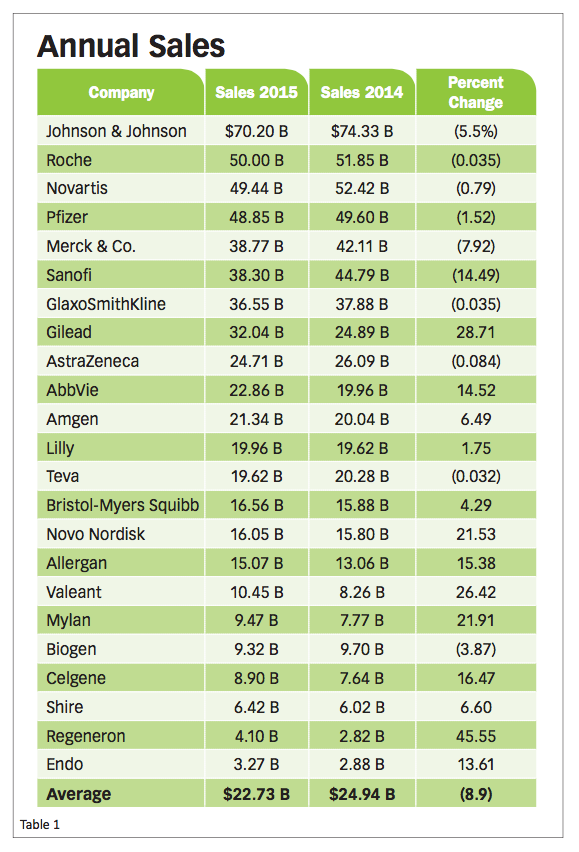
Assuming this is true, then Table 1 results suggest possible trouble ahead for the biggest integrated global majors-a group we designate as the “Mainstream Eight,” each of whom went backward in sales in 2015. Sanofi fared worst, with sales down by more than 14% compared to 2014, followed by Merck (-7.92%), J&J (-5.5%) and Pfizer (-1.52). Teva (-0.032) and Biogen (-3.87) were the other two of the 23 that booked lower sales in 2015 compared to 2014. Still, the results indicate that development portfolio restructuring, intensified cost controls and strategic investments in operational efficiency has, for many big Pharma, arrested the slide in sales revenue growth, with Roche, Novartis, GlaxoSmithKline, AstraZeneca and Teva all keeping the drop to less than a percentage point over 2014.
On the flip side, Regeneron was the clear sales winner, increasing sales by more than 45% as a consequence of the success of products like Eylea. Gilead Sciences was the other standout here, with its bulging hepatitis C virus presence, followed by Valeant, where the bias was clearly centered on its performance up to mid-year 2015.
Sales revenue for the group as a whole dropped 8.9%. Sales for those in the smaller, “stealth pharma” bloc, however, generally increased-driven by a focus on biotech applications in rare diseases and hard-to-treat conditions, where price resistance is minimal. The trend is confirmed by several analyses showing the majority of FDA approved drugs since 2010 have come from smaller companies-64% of them in 2015, according to HBM Partners. Another trend worth noting is the role that several years of intense M&A activity has played in pushing up revenue growth. This has helped some of the larger companies compensate for their increasing difficulty in delivering organic growth through in-house labs.
Enterprise value & enterprise value percentage growth
Table 2 on Enterprise Value shows the change for 2015 over 2014 for the 23 companies was 6.8%. Enterprise value as a Percent of Growth is arrived at by evaluating market capitalization (the number of common stock shares outstanding multiplied by the price of the stock on a given day) plus cash and cash-like liquid assets, minus debt and liabilities. The higher this ratio
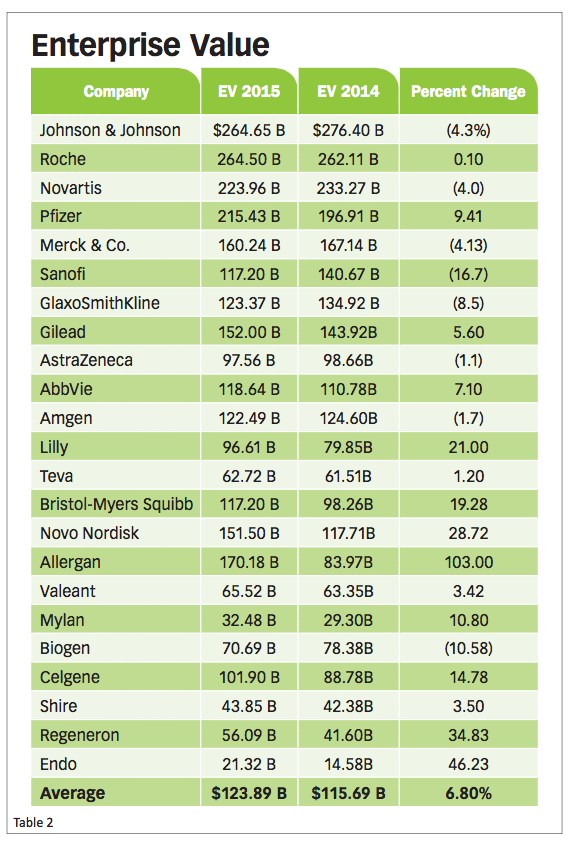
is, the higher the value of the company. Enterprise Value (EV) is directly related to shareholder value. The most valuable biopharma firm in the world is J&J with an EV at the end of December 2015 of $265 billion, a drop of 4% compared to 2014.
The feeding frenzy stemming from M&A deals proved to be a significant base for EV increases at Actavis (now Allergan), Valeant, Mylan, Endo, Shire and AstraZeneca. Some of the acquisitions seem a bit overpriced, with market capitalization to sales ratios moving firmly upward-witness AbbVie’s 29 times multiple for its 2015 purchase of Pharmacyclics. The siren song of reducing costs is also stated as a goal of EV consolidation, but Doug Sherlock, a healthcare analyst, estimates that only 15% to 20% of SGA activity is driven by a desire to exploit the economies of scales in mergers.
Enterprise value to sales
The EV/Sales ratio reflects a market assessment of future growth and

profitability. The higher the ratio suggests that a firm’s best days are ahead; the lower the ratio, it means the firm has hit a mature phase where growth and/or profitability has peaked. The robustness of company pipelines has a lot to do with this marker. Table 3, EV to Sales, shows the average ratio for 2015 was 6.08 times sales, compared to 5.75 times sales in 2014. Regeneron was the big winner in 2015, with a host of new products led by the cash cow ophthalmology drug Eylea and its lead role in developing the PCSK9 line of anti-cholesterol drugs.
Gross margin
Table 4 shows Gross Margin, defined as Sales Revenue minus the Cost of Goods Sold. This metric reflects a firm’s ability to price. The higher gross margin, the more power the company has to raise prices. Demonstrating that capacity consistently, year after year, is a mark of true distinction. That ability to raise prices and then keep them high over time is best seen among the elite class we call the “Five Horsemen of the Apothecary:” Celgene (a 92.15% gross margin); Regeneron (88.61%); Gilead (87.15%); Novo Nordisk (85.00%); and Biogen (82.59%). The average Gross Margin for the entire 23 firms in 2015
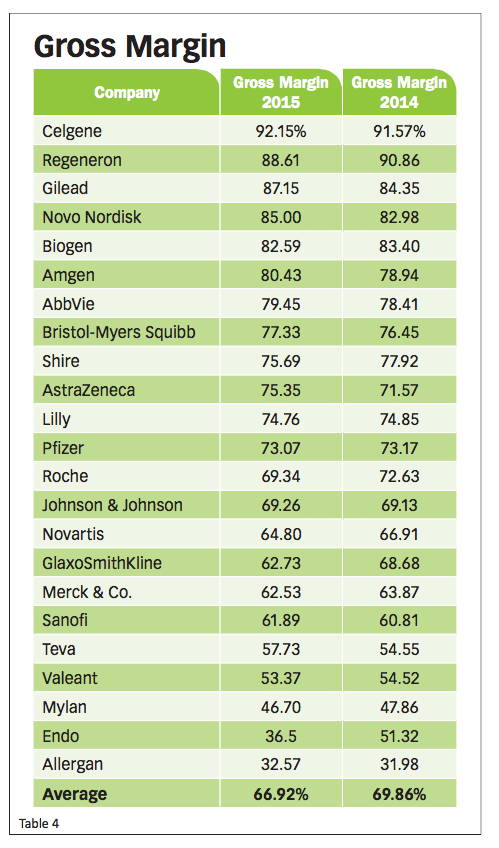
was 66.92%, compared to 69.86 % in 2014, a slight decrease. Needless to say, such numbers are substantially higher-in the nosebleed range-than the average in nearly all other industries. In spite of the reputation hit, it’s a nice problem to have.
The mega-investor Warren Buffet characterizes pricing power as “the moat surrounding and protecting your castle.” As drug costs becomes a more prominent issue in the media, investigatory reports have revealed that the prices of many older, established medicines are being raised at double-digit rates, eroding the traditional argument that therapeutic class competition would breach that moat and bring prices down.
However, political gridlock in Washington and the absence of a single-payer regulatory authority appears to be keeping “fortress pharma” impregnable, at least for the time being. Higher pricing for existing meds now seems to be baked in as a substitute for the risk inherent in longer development lead times and a slow building uptake after launch. A recent Fortune magazine survey found that AbbVie’s percentage of three-year worldwide growth that came from pricing increases was 112%, with BMS at 47%, followed by Pfizer at 34%. But no one should forget that the collapse of high-flying’s Valeant market cap after repeated pricing scandals indicates that chinks in the industry’s pricing armor could lead to the collapse of the Valeant bottom-feeding business model, tainting the entire industry unless more care is paid to demonstrating value as justification for those high margins. The decline in average gross margin for the 23 in 2015 suggests more prudence in interpreting the sentiments of payers and patients might be in order going forward.
Net income to sales
Table 5 is an indicator of profitability-earnings before interest, taxes,

depreciation, and amortization (EBITDA) in relation to sales revenue. Net Profit is arrived at after subtracting operating expenses from Gross Margin. Net Profit to Sales is your profit margin.
The profit margin measures how well the company deals with sales; pricing; cost of goods sold; ingredients used in manufacturing products; operating expenses; and discounts, rebates, and royalties, if any. If you cannot grow revenues, then the appropriate management fallback response is to get a better handle on operating expenses. Significantly, overall profitability for the Audit 23 decreased from 21.02% in 2014 to 20.25% in 2015. This does not obscure the fact that the biopharmaceutical industry is a very profitable sector: compare that 20.25% net profit margin to the average profitability of the Fortune 500 companies, at about 8%.
Gilead is once again the top performer on this metric due to its relentless focus on financial rigor and operations efficiency, starting with a low employee headcount compared to other firms of equivalent size. Valeant, Endo, and Allergan bring up the rear, all with negative ratios where expenses exceed income.
Sales to assets
Table 6, Asset Management, relays how well a firm fares in managing its collective assets, including cash, accounts receivable, property, equipment, and
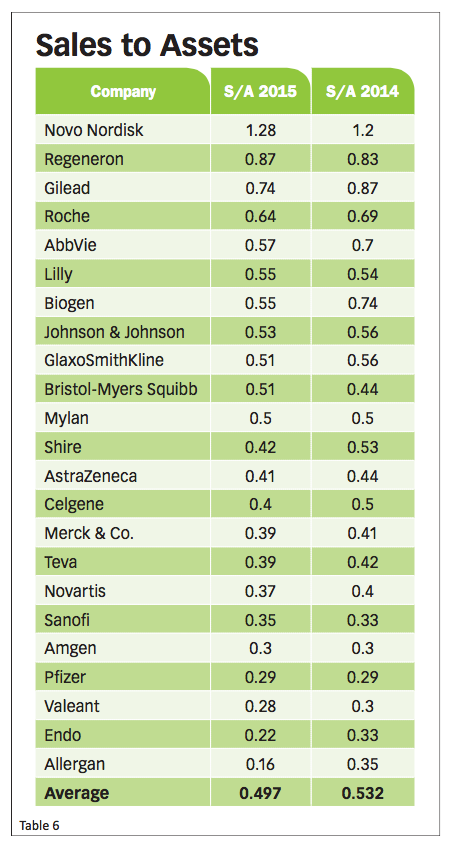
inventory. The ratio reflects what a firm gets back in return for every dollar it invests in these assets. Setting the high bar at the top of Table 6 is Novo Nordisk, with a Sales to Assets ratio of 1.28; that is, for every dollar Novo Nordisk invests in assets, it generates $1.28 in return. The average Sales to Assets ratio for 2015 was .0.497, which means that the Danish drugmaker posted a performance three times better than the rest of the 23.
Return on assets
When you multiply Profit to Sales times Sales to Assets, you get Profit to Assets, a very important metric. Table 7 below, Return on Assets, is much more informative than just the Profit Margin because it measures how well a company is managed, that is, how good the firm is at not just margin management, but at effectively deploying its assets as well. The average for the 23 is slightly down for 2015 compared to 2014, at 10.15 versus 10.7. The real news is the top scorer, Gilead, with its stunning Return on Assets metric of 41.87. Novo Nordisk is a close second, at 41.29, with the entire rest of the field lagging well behind. Gilead’s number is actually on par with other firms’ Gross Margins. Clearly, Gilead runs a very tight operation compared to other biopharma giants, employing only 7,000 people worldwide. The key question is now that it has doubled its gross revenues in the space of only two years since the launch of its lucrative HCV franchise, will it loosen the purse strings and start spending at levels commensurate with a top 10 big Pharma?
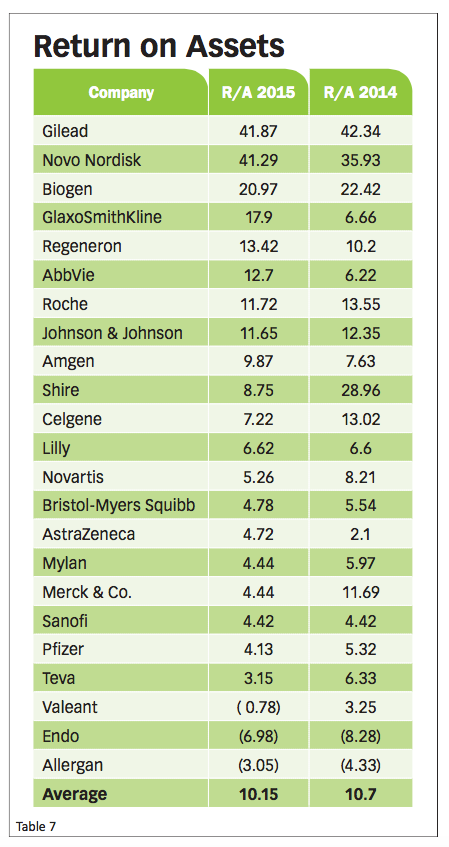
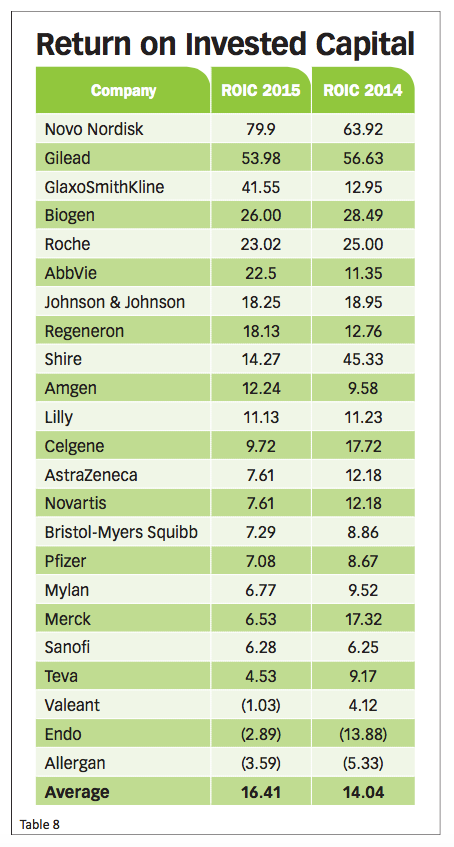
Return on invested capital
As with Return on Assets, Table 8 above, Return on Invested Capital (ROIC), is a measure of how well a firm is managed. No financial gimmickry here, just the result of how good management is at investing in assets and getting a return on those assets through solid strategies, sensible execution, and a commitment to operational efficiencies. ROIC increased on average for our 23 firms from 14.04 in 2014 to 16.41 in 2015, with Novo Nordisk at the top, at 79.92, followed by Gilead at 53.98. Again, putting these numbers in perspective, they surpass pre-tax margins. But it is also true that 14 of the 23 post a metric lower than 15, which is roughly equivalent to the weighted average cost of capital (WACC), currently running anywhere from 10% to 15%. It means that more than half of the 23 are not covering their cost of capital.
Also, it’s worth comparing the ROIC and Return on Assets that measure
performance to financial machinations such as stock buybacks and dividend gifts. Such maneuvers lift earnings per share, which is then impacted by higher price to earnings multiples, rewarding shareholders-but without necessarily investing in the business for long-term gain. The trend is fairly well established now, with companies like Amgen and Biogen that once refused now offering share buy-back programs or dividends. These bigger biotech are copying the mainstream big Pharma in catering to the desire of shareholders for value beyond advances in share price.
Net profit per employee
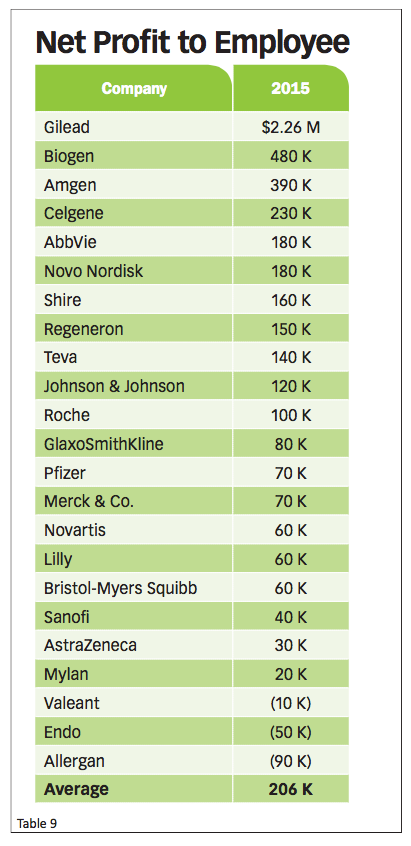
Table 9 shows the profit generated per employee, which is a reliable measure of productivity. Gilead is at the top here, with each employee producing $2.26 million in profit for 2015. There is a dramatic dropoff to the No. 2, Biogen, which bagged $480,000 per employee, with the remainder of the 23 even further behind. Putting the two numbers in perspective, Apple’s profit per employee is about $500,000. Big box retailer WalMart’s profit per employee is about $7,000. Clearly, headcount costs money.
Selling, general and administrative expenses to sales
Table 10 shows a very important metric: SGA to Sales. It’s strategically prescient, even though it is less useful in measuring year-on-year performance. In general, SGA growth should not exceed growth in sales or it will start cutting into profitability. Another word for SGA is “overhead,” and when this is above average for the sector or increasing at a faster pace than sales, the firm becomes bloated and less productive. In terms of the Audit, it all depends on the aim behind that overhead-for a short period, a company may need to make major investments in promotion or marketing or add to its production and distribution infrastructure. Hence, over a defined period, SGA can exceed sales growth. In Table 10, we see that the
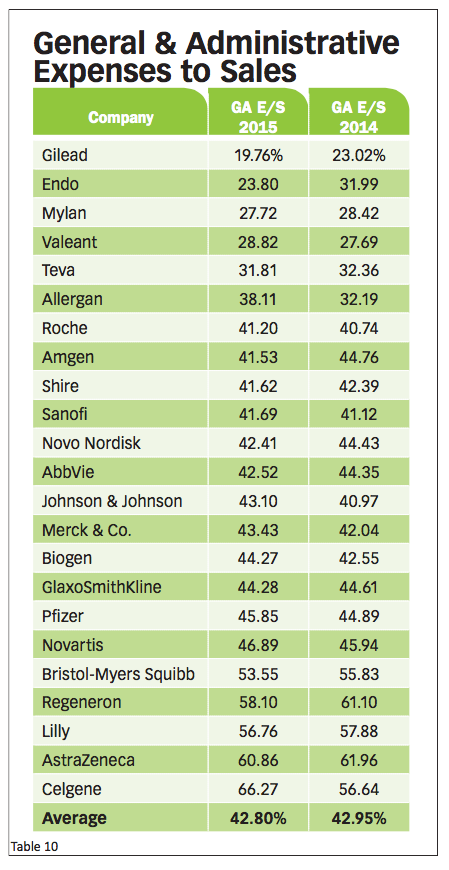
companies on this year’s list are slowing the rate of SGA growth, which averaged 42.95% of sales in 2014, slightly decreasing to an average of 42.8% in 2015.
More attention to this metric is required. To maintain present high levels of profitability, the IMS Institute for Health Informatics estimates that drugmakers will need to reduce their SGA by $36 billion in the next two years. This reinforces McKinsey & Co.’s ongoing analysis of healthcare productivity. Productivity rates for healthcare overall over the time period 1990– 2007 have dropped by minus 0.8% while employment numbers have gone up by 3%.
As a way to gauge whether SGA expenditures are justified, it makes sense to look at company income statements and scrutinize how many ad agencies the company is working with. If the number can be reduced, that can lead to savings in SGA. The supply chain can also be looked to for savings and efficiencies, as each supplier’s value chain, or gross margin, impacts operating expenses. Note how high the SGA is for the self-proclaimed new biotechs like AstraZeneca and Celgene both have a SGA metric about 20 percentage points higher than the group average of 42.8%. Execution capabilities are always critical: consider how GSK will address the substantial restructuring costs as it integrates 12,000 employees into its expanded consumer and vaccine businesses while trying to offset SGA costs with tactics like reducing drug packaging variants and streamlining its external supply chain network.
And the winner is ...
Our final Table 11 reveals the Winner for 2016: Novo Nordisk. Last
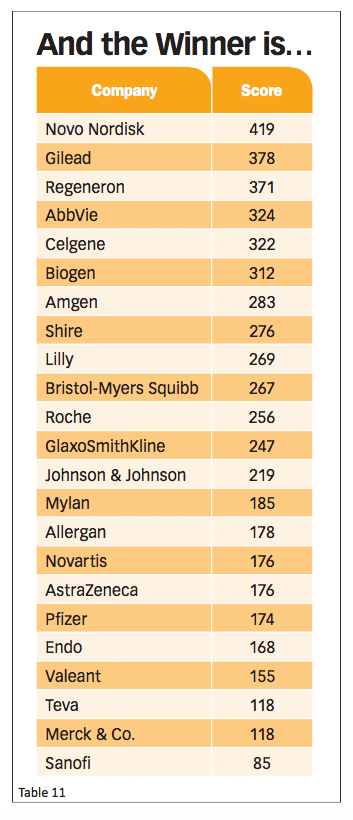
year’s victor, Gilead, switches place with Novo, taking second, while Regeneron moves up the ranks, to third, from sixth in 2015. AbbVie, at fourth, claims a big
Pharma spot in our list’s top five, with an even more dramatic rise from 10th place in 2015. AbbVie, by continuing to wrest every last drop of profit from its market-dominating Humira franchise, secured its place by exhibiting a characteristic common to all winners since our first Audit in 2002: mastery of the pricing domain.
Clearly, the innovative side of biopharma is continuing to hold its own. These top achieving stealth players, along with BMS, are focused on new ground-breaking clinical pathways and narrow therapeutic markets. Other companies among the 23, especially those in the generics and brand generic spaces, are pursuing strategies to boost scale. With the recent merger frenzy among the top five health insurers and managed care providers, consolidation on the payer side is increasing, which
Biopharma vs. high-tech; click to enlarge
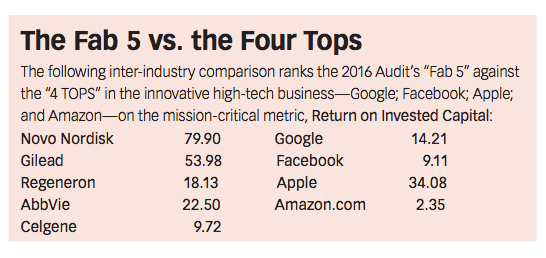
simply makes pricing freedom all the more essential in helping differentiate the biopharma winners from the also-rans. Asset pruning to allow companies to focus on the segments of business where they are ahead is another theme that will dominate the Audit landscape this year.
Is there a spanner in the works? Potentially, yes-it’s that turf turning shovel called pricing. Even with the outcries over the shelf-stuffing practices of Valeant and Turing’s strategy to game the regulatory system to achieve price monopolies in areas where there are no other drug alternatives now fading, it is clear that the policy and legislative communities, as well as patients, are not buying into the industry’s message of pricing for value. Expect more of a downward tilt to the harbinger of price sentiment, Gross Margins, in our next report.
Bill Trombetta, PhD, is Professor of Healthcare Marketing at St. Joseph’s University Haub School of Business in Philadelphia. He can be reached at trombett@sju.edu
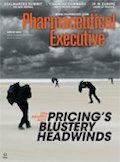
Cell and Gene Therapy Check-in 2024
January 18th 2024Fran Gregory, VP of Emerging Therapies, Cardinal Health discusses her career, how both CAR-T therapies and personalization have been gaining momentum and what kind of progress we expect to see from them, some of the biggest hurdles facing their section of the industry, the importance of patient advocacy and so much more.
